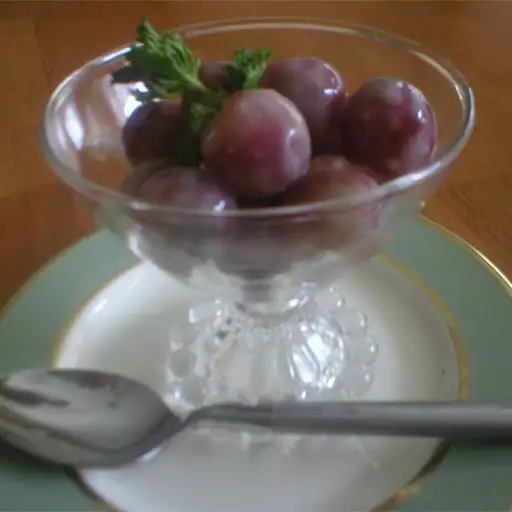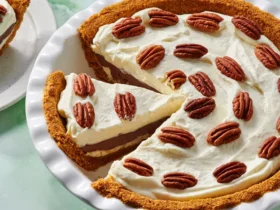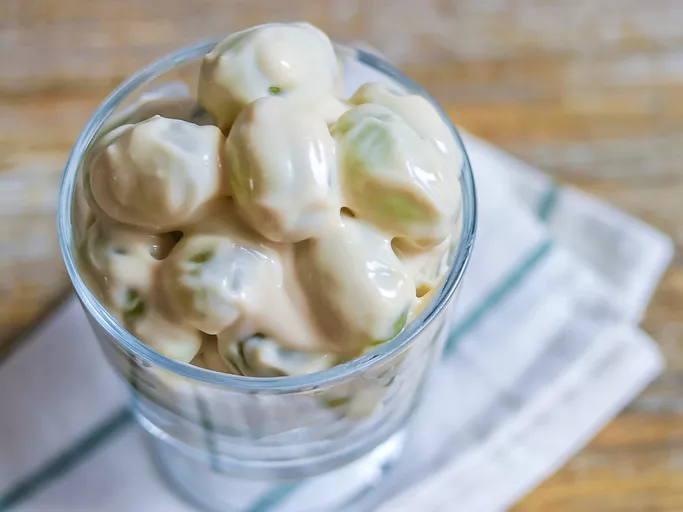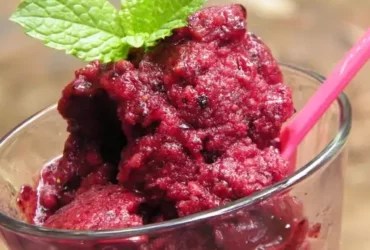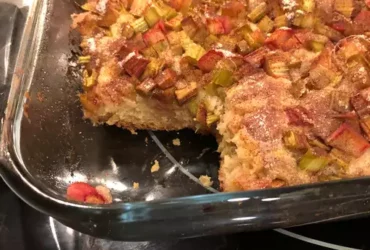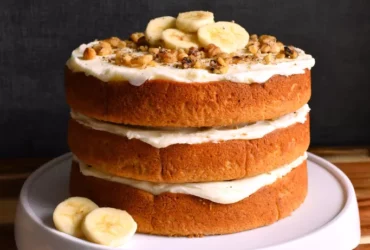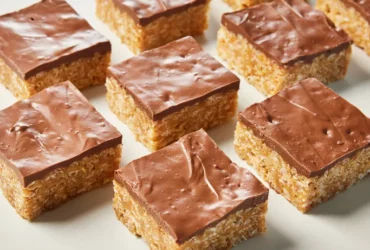Ingredients
You’ll need
You’ll need:
For the Caramel Grapes, you will require the following ingredients:
- Grapes: A bunch of fresh red or green grapes, preferably seedless.
- Creamy caramel sauce: Store-bought or homemade caramel sauce is perfect for this recipe. You can also use dulce de leche as a substitute.
- Heavy cream: For the creamy and rich texture, you will need heavy cream to mix with the caramel sauce.
- Vanilla extract: A few drops of vanilla extract enhance the flavor of the caramel grapes. You can adjust the amount according to your taste preferences.
- Powdered sugar: To balance out the sweetness and add a touch of elegance, powdered sugar is necessary for dusting the caramel grapes.
- Water: A small amount of water can be added to thin out the caramel sauce if needed. However, be cautious not to make it too runny.
Please note that you may also require some additional ingredients such as a saucepan for heating the caramel sauce, a spatula for mixing and folding the grapes, and parchment paper or a baking sheet for setting the caramel grapes aside to cool.
1 cup of red or green grapes
Grapes are one of the primary ingredients in this delicious caramel recipe. For this particular recipe, we’ll be using 1 cup of fresh grapes that can be either red or green.
The choice between red and green grapes comes down to personal preference and the desired color of your final product. Red grapes will give a deep reddish-pink hue to your caramelized grapes, while green grapes will result in a pale yellow-golden appearance.
It’s essential to use fresh grapes for this recipe, as they have a higher sugar content and natural sweetness compared to wilted or overripe grapes. The best varieties of grapes to use are those that are heavy for their size, plump, and have a slight sheen to them.
When selecting green grapes, look for the following characteristics:
- Varieties such as Thompson Seedless or Green Flame will work well
- Choose grapes with a deep green color and a slightly yellowish tint on the skin
- Avoid grapes that are overly soft or have brown spots, as they may be past their prime
When choosing red grapes, consider the following:
- Varieties such as Flame Seedless or Ruby Red will produce the desired color
- Opt for grapes with a deep red-purple hue and a slight sheen to them
- Be wary of red grapes that are too pale or have an unnatural sheen, as they may be overripe
Regardless of the grape color you choose, ensure that they’re clean and free of debris before using them in your caramel recipe.
1/4 cup of granulated sugar
When it comes to making caramel grapes, one of the essential ingredients is granulated sugar. This type of sugar is perfect for creating a crunchy and sweet exterior, which will complement the chewy texture of the grapes. One-quarter cup of granulated sugar may seem like a small amount, but it’s enough to coat a decent-sized batch of grapes evenly.
Granulated sugar, also known as white sugar or table sugar, is made from sugarcane or sugar beets. It’s composed of sucrose molecules that are crystallized together in a process called granulation. The resulting crystals have sharp edges and corners, which will help to create the crunchy texture we’re looking for.
The use of granulated sugar in this recipe is particularly well-suited because it doesn’t contain any added ingredients like molasses or flavorings that can affect the taste and texture of the caramelized sugar. This means that you’ll get a pure, unadulterated caramel coating on your grapes without any unwanted flavors.
When using granulated sugar to make caramel for your grapes, it’s essential to keep an eye on the temperature as it melts. The ideal temperature range for making caramel is between 338°F and 345°F (170°C to 173°C). If you heat the sugar too much, it can burn or become discolored, resulting in a bitter taste.
One-quarter cup of granulated sugar is equivalent to about 60 grams. This amount should be sufficient for coating around 20-25 grapes, depending on their size and shape. To ensure that your grapes are evenly coated with the caramelized sugar, you may need to adjust the amount of sugar slightly based on the size and number of grapes.
1 tablespoon of unsalted butter
- The first ingredient needed for the Caramel Grapes recipe is one tablespoon of unsalted butter.
- This type of butter serves multiple purposes in the recipe, including helping to caramelize the sugar and bringing out the natural flavors of the grapes.
- Unsalted butter has no added salt, which allows the sweetness of the caramelized sugar to shine through without any bitter undertones from the salt.
- Using unsalted butter also provides a neutral flavor profile that complements the fruitiness of the grapes, allowing their natural sweetness to take center stage in the recipe.
- When selecting an unsalted butter for this recipe, it’s essential to choose a high-quality option with a high fat content, as this will help create a rich and smooth caramel sauce.
1 teaspoon of vanilla extract
The ingredient list for the Caramel Grapes Recipe typically includes a variety of sweet and tangy elements to create a delicious and visually appealing treat.
One of the key ingredients used in this recipe is vanilla extract, which serves several purposes beyond just adding flavor.
Vanilla extract is derived from the seed pods of the vanilla orchid, specifically through a process of extraction that involves soaking the pods in a solvent such as ethanol or glycerin.
This extraction process releases the aromatic compounds present within the seeds, resulting in a concentrated liquid with a sweet and creamy aroma.
Vanilla extract is commonly used as a flavoring agent in baking and cooking due to its distinct and recognizable taste, which is often associated with sweetness and warmth.
In the context of the Caramel Grapes Recipe, the teaspoon of vanilla extract will contribute to the overall flavor profile of the dish.
The subtle sweetness of the vanilla pairs well with the natural sweetness of the grapes, while its creamy undertones enhance the caramel sauce’s richness.
When working with vanilla extract in a recipe like this, it is essential to note that the amount used can greatly impact the final flavor and aroma of the dish.
A general rule of thumb when using vanilla extract is to start with small quantities – such as 1/2 teaspoon or 1 teaspoon for every 8 ounces of batter or mixture – and adjust to taste, as excessive amounts can overpower the other flavors present.
Optional ingredients
The key ingredients for this recipe include:
- Grapes (red or green): These are the main component of the dish and provide the natural sweetness and flavor. Choose a variety that is sweet and juicy, such as Muscat or Thompson Seedless.
- Granulated sugar: This ingredient will help to balance out the natural tartness of the grapes and create a caramelized coating. Brown sugar can also be used for a deeper flavor.
- Water: A small amount of water is needed to dissolve the sugar and help it stick to the grapes during cooking.
- Butter or oil: Adding a bit of fat helps to prevent the grapes from sticking together and adds a richness to the dish. You can use either melted butter or a neutral oil like canola or grapeseed.
- Optional ingredients that can enhance the flavor and texture include:
- Salt: A pinch of salt will help to balance out the sweetness of the sugar and grapes, while also bringing out their natural flavors.
- Vanilla extract or vanilla powder: Adding a hint of vanilla can enhance the sweetness and aroma of the dish. Use a high-quality pure vanilla extract for the best flavor.
- Nutmeg or cinnamon: A pinch of warm spices like nutmeg or cinnamon can add depth and warmth to the caramelized grapes, especially if you’re serving them as a side dish for holiday meals.
- Lemon juice or zest: Adding a squeeze of fresh lemon juice or some grated lemon zest can provide a bright, citrusy contrast to the sweetness of the sugar and grapes. This is a great option if you want to balance out the flavors and add a bit of acidity.
A pinch of salt
The success of any recipe heavily relies on the quality and freshness of its ingredients, especially when it comes to sweet treats like caramel grapes. The foundation of this delightful dessert lies in the choice and combination of ingredients used.
For a classic take, you’ll typically need:
- Ripe red or green grapes, preferably seedless for better texture
- Sugar – granulated white sugar works best to achieve the right balance between sweetness and crunch
- Water – used both in the caramel making process and as a rinse after coating the grapes with sugar
- Unsalted butter or vegetable oil for greasing utensils and the baking sheet, ensuring smoothness without adding any unwanted flavors to your dish
- Heavy cream or milk (optional) – used to achieve a richer flavor profile and texture by mixing into the caramel mixture before coating the grapes
- A pinch of salt – essential for bringing out the natural sweetness in both the grapes and the caramel, preventing it from tasting overly sugary. However, the key here is balance; too much salt can overpower your dish.
- Any additional flavor enhancers you desire (optional) such as vanilla or cinnamon powder – these add a depth of taste to complement the sweetness and provide an exciting twist on the classic recipe.
The art lies in the balance between salt and sugar, which may vary based on personal preference. Some find that just a pinch of salt enhances the sweetness without overpowering it, while others prefer a hint of vanilla for added depth or a sprinkle of cinnamon to warm up the flavor profile.
Instructions
To make the caramel coating
Cooking caramel for the caramel grapes recipe requires attention to detail and a bit of patience, but with these instructions, you’ll be able to achieve a smooth and delicious coating.
First, combine 1 cup (200g) granulated sugar and 1/2 cup (120ml) water in a medium saucepan. Place the saucepan over medium heat and stir until the sugar dissolves completely.
As the mixture reaches its boiling point, you will see a light-colored film on top of the liquid. Continue to cook for about 10-15 minutes, without stirring, or until the caramel turns a deep amber color and develops a rich, nutty aroma.
To check if your caramel is ready, remove it from the heat and carefully tilt the saucepan slightly. If the caramel slowly flows back into the center of the pan, it’s ready to coat your grapes. If not, continue cooking for another minute or two and testing again until you reach the correct consistency.
Once the caramel has cooled slightly but is still warm and runny, carefully dip each grape into the saucepan, letting any excess caramel drip off before placing it on a parchment-lined baking sheet. Repeat this process with all of your grapes to ensure an even coating.
To help set the caramel on the grapes quickly, place the baking sheet in the refrigerator for about 30 minutes. Alternatively, you can let them cool at room temperature, but be aware that they may stick together slightly due to the moisture from the grapes and caramel.
Finally, enjoy your beautifully coated caramel grapes, perfect for a sweet snack or dessert! Store any leftover grapes in an airtight container in the refrigerator for up to 3 days.
Combine sugar and butter in a saucepan over medium heat, stirring until the sugar dissolves.
Instructions for making caramel grapes are designed to ensure that the process yields a delicious and visually appealing dessert. To start, combine sugar and butter in a saucepan over medium heat.
The first step involves combining two key ingredients: sugar and butter. The ratio of sugar to butter can be adjusted according to personal preference or the specific recipe being used. However, as a general guideline, a 2:1 ratio of sugar to butter is often recommended for making caramel sauce. This means that for every 2 parts of sugar, use 1 part of butter.
Once the sugar and butter are combined in the saucepan, place it over medium heat. The heat should be gentle enough not to burn the mixture but intense enough to melt the butter and dissolve the sugar. It is crucial to monitor the temperature of the mixture closely to avoid overheating or burning the sugar.
As the sugar dissolves and the mixture heats up, it will begin to turn into a smooth, amber-colored liquid. This process can take anywhere from 5-10 minutes, depending on the heat level and the amount of sugar being used. It’s essential to stir the mixture regularly during this time to ensure even heating and prevent scorching.
Once the caramel sauce has reached the desired consistency and color, remove it from the heat immediately. The sauce will continue to thicken as it cools down, so it’s crucial not to overcook it, or it may become too thick and sticky.
To assemble the caramel grapes, allow them to cool completely before dipping each grape into the warm caramel sauce. The ideal temperature for dipping is between 180°F to 190°F (82°C to 88°C). This will help prevent the grapes from melting in the caramel and ensure a smooth, even coating.
Finally, place the dipped grapes on a wire rack or parchment paper to cool completely. As they set, the caramel sauce will harden into a beautiful, golden-brown shell that surrounds each grape. The result is a delicious and visually stunning dessert perfect for special occasions or everyday snacking.
Bring to a boil, then reduce heat to low and simmer for 57 minutes or until the mixture turns golden brown.
This step of the caramel grapes recipe requires attention to detail and a gentle touch, as we aim to coax out the natural sugars in the mixture and turn them into a rich, golden-brown caramel sauce.
The first instruction, ‘bring to a boil’, is crucial in initiating the cooking process. This stage involves heating the mixture to its boiling point, which can be identified by watching for bubbles forming rapidly on the surface and hearing a gentle roar as the liquid transitions from a simmer to a full-blown boil. It’s essential to maintain a close eye during this phase, as over-boiling can lead to a loss of control.
Once the mixture has reached its boiling point, it’s time to ‘reduce heat to low’ and begin the simmering process. This is where the magic happens, as the reduced heat allows for a gentle, controlled cooking environment that enables the sugars within the mixture to break down and develop their characteristic caramel flavors.
The instruction to ‘simmer for 57 minutes’ may seem somewhat precise, but it’s this level of specificity that yields the perfect balance between sweetness and depth. The prolonged simmering time gives the sugar molecules ample opportunity to interact with each other and the surrounding liquid, ultimately resulting in a smooth, velvety caramel sauce.
The final stage, ‘until the mixture turns golden brown’, serves as a visual cue to indicate that the caramelization process is complete. At this point, the sauce will have transformed from a pale amber color to a rich, deep gold, signaling its readiness for use in the caramel grapes recipe. This golden hue is not only visually appealing but also indicative of the complex flavors and aromas that have developed during the cooking process.
In summary, bringing the mixture to a boil, reducing heat to low, simmering for 57 minutes, and waiting for it to turn golden brown are all critical steps in creating a high-quality caramel sauce for the caramel grapes recipe. By following these instructions carefully, home cooks can produce a delicious, sticky, and utterly addictive caramel sauce that elevates their dish to new heights.
Remove from heat and stir in vanilla extract.
When preparing the Caramel Grapes Recipe, it’s crucial to follow the instructions carefully to achieve the perfect sweet and sticky treat. One such instruction is Remove from heat.
This step involves carefully taking the caramel sauce off the stove or heat source to prevent it from burning or becoming too dark in color. It’s essential to remove the pan from the heat as soon as the desired level of doneness is reached, which can be achieved when the caramel turns a light golden brown color.
Once the pan has been removed from the heat, the next step is Stir in vanilla extract. This involves adding a small amount of vanilla extract to the caramel sauce and gently stirring it in with a spoon until well combined.
The addition of vanilla extract not only adds a subtle flavor to the caramel sauce but also helps to balance out any bitterness or harshness that may have developed during the cooking process. It’s essential to use high-quality vanilla extract for this step, as it will make a significant difference in the overall taste and aroma of the Caramel Grapes.
When stirring in the vanilla extract, be sure to do so gently to avoid introducing any air into the caramel sauce, which can cause it to become too light or even separate. Simply stir the mixture until the vanilla extract is fully incorporated, then set the pan aside to allow it to cool slightly before continuing with the recipe.
To coat the grapes
To coat the grapes, start by selecting fresh and plump grapes for the best results. Wash the grapes thoroughly under cold running water to remove any dirt or bacteria that may be present on their surface. Pat them dry with a clean paper towel to prevent excess moisture from interfering with the coating process.
Next, prepare the caramel sauce according to your recipe. You can either make it from scratch using granulated sugar, heavy cream, and butter, or use store-bought caramel syrup as a shortcut. If making your own caramel, heat the sugar in a medium saucepan over low heat, stirring constantly until it dissolves. Bring the mixture to a boil, then reduce the heat to medium-low and simmer for about 10-15 minutes, or until it reaches a deep amber color and develops a rich aroma.
Once the caramel is ready, remove it from the heat source and let it cool slightly. You want it to still be warm but not hot enough to burn your skin when you touch it. If using store-bought caramel syrup, simply stir it gently to reheat it if needed.
To coat the grapes with the caramel sauce, dip each grape individually into the warm sauce, making sure to fully submerge it. You can also use a dipping tool or a fork to coat multiple grapes at once for more efficiency. Alternatively, you can place the grapes on a baking sheet lined with parchment paper and pour the caramel sauce over them, using a spatula or spoon to coat evenly.
As the grapes cool, they will start to set and develop their sticky coating. You can speed up this process by placing them in the refrigerator for about 10-15 minutes before serving. Be careful not to over-cool them, as this can cause the caramel to become too brittle or even crack off the grapes.
Before serving, arrange the coated grapes on a platter or individual plate and garnish with fresh mint leaves or other edible flowers for added color and visual appeal. You can also use the caramel-grapes as toppings for ice cream sundaes, cakes, or other desserts.
For an extra touch of indulgence, consider adding chopped nuts or sprinkles to the caramel sauce before coating the grapes. This will add a satisfying crunch and flavor contrast to each bite. Simply mix in your choice of toppings into the warm caramel sauce until they’re evenly distributed, then proceed with coating the grapes as usual.
Dip each grape into the hot caramel mixture using a fork or dipping tool.
The instructions provided for creating caramel grapes emphasize the importance of handling the grapes with care to achieve the desired level of caramelization.
Dipping each grape into the hot caramel mixture using a fork or dipping tool is a critical step that requires attention to temperature and timing.
When working with hot caramel, it’s essential to have a thermometer on hand to ensure the mixture reaches a safe temperature for coating grapes without burning them.
The ideal temperature for caramel is between 235°F (118°C) and 240°F (115°C), which allows for a smooth and even coating.
Using a fork or dipping tool helps to handle the grapes gently, preventing bruising or breaking, while also enabling precise control over the amount of caramel applied.
It’s crucial to coat each grape thoroughly but not overdo it, as excessive caramel can make the grapes difficult to bite into and overpower their natural sweetness.
To achieve a perfectly coated grape, you may need to adjust your dipping technique or temperature slightly depending on your personal preference for caramel thickness.
Some individuals prefer a delicate, almost translucent coating, while others enjoy a richer, more indulgent caramelized effect.
Ultimately, the key to successful caramel grapes is achieving that perfect balance between sweetness and texture.
By following these steps carefully and experimenting with different techniques, you can create an irresistible snack or dessert that combines the natural flavor of grapes with the indulgent charm of caramel.
Tips & Variations
Experiment with different flavors
Caramel grapes are a sweet and indulgent treat that can be enjoyed as a snack, dessert, or even used as a topping for ice cream or yogurt. If you’re looking to mix things up and try new flavors, here are some tips and variations to experiment with:
Flavor Combinations:
- Caramel Apple Grapes: Add a hint of cinnamon and nutmeg to the caramel mixture for a flavor reminiscent of apple pie.
- Strawberry Basil Grapes: Infuse the grapes with fresh basil leaves and pair with a sweet strawberry sauce for a unique twist.
- Pecan Pie Grapes: Mix in some chopped pecans and a hint of maple syrup to give the caramel a nutty flavor, perfect for fall.
Spice It Up:
- Cayenne Pepper: Add a pinch of cayenne pepper to give the caramel a spicy kick.
- Ginger: Mix in some grated ginger for an Asian-inspired flavor.
- Nutmeg: Add a few grates of nutmeg to give the caramel a warm, comforting flavor.
Dessert Variations:
- Caramel Grapes Trifle: Layer the grapes with whipped cream, chocolate shavings, and toasted nuts for a decadent dessert.
- Caramel Grapes Tarts: Arrange the caramel grapes on a bed of jam in pre-made tart shells for an elegant dessert.
Tips & Tricks:
- Use high-quality chocolate or chocolate chips to get the best flavor out of the caramel mixture.
- Skip the sugar and use a natural sweetener like honey or maple syrup if you prefer.
Try adding a pinch of salt to balance out the sweetness
- The art of balancing flavors is a crucial aspect of any recipe, and our Caramel Grapes recipe is no exception.
- In this section, we will delve into the world of flavor pairing and provide you with some tips and variations to take your caramelized grapes to the next level.
Adding a Pinch of Salt: A Game-Changer
- The sweetness of the caramel can be overpowering at times. To counteract this, try adding a pinch of salt to balance out the flavors.
- This may seem unconventional, but trust us when we say that it makes all the difference. The flaky sea salt or Kosher salt will help cut through the richness of the caramel and add depth to the dish.
Tips for Achieving the Perfect Caramel Grapes
Here are some additional tips to ensure that your caramel grapes turn out perfectly:
- Slice the grapes thinly to ensure they caramelize evenly.
- Don’t overcrowd the baking sheet, as this can cause the grapes to stick together.
- Use a gentle heat, as high temperatures can burn the caramel and ruin the dish.
Variations on the Caramel Grapes Recipe
Now that you have mastered the basic recipe, it’s time to get creative. Here are some ideas for variations:
- Add a sprinkle of nutmeg or cinnamon to give your caramel grapes a warm and spicy flavor.
- Mix in some chopped nuts, such as almonds or pistachios, for added texture and crunch.
- Use different types of sugar, like brown sugar or Demerara sugar, to create a unique flavor profile.
Conclusion
We hope that this article has inspired you to try new flavors and variations on the classic caramel grapes recipe.
Remember, the key to achieving success in cooking is experimentation and creativity. Don’t be afraid to add your own twist and make the dish your own!
Use other types of sugar, like brown sugar or turbinado sugar, for a different flavor profile.
Certain types of sugar can be used to create different flavor profiles in the Caramel Grapes Recipe. For instance, brown sugar adds a rich and caramel-like flavor, while turbinado sugar provides a subtle hint of vanilla.
Another option is using muscovado, which has a distinct, deep molasses flavor that pairs well with the sweetness of grapes. Keep in mind that muscovado sugar is often more expensive than other types of sugar and has a stronger flavor, so use it sparingly.
Some people prefer to use honey as an alternative sweetener for the caramel sauce. Honey can add a distinct flavor profile to the recipe and provides some health benefits due to its antibacterial properties. However, keep in mind that honey has a different texture than sugar and may affect the consistency of the caramel sauce.
Piloncillo is another type of sweetener that can be used in place of sugar in the Caramel Grapes Recipe. Piloncillo is an unrefined cane sugar that adds a rich, molasses-like flavor to the dish. It’s a good option for those looking to avoid refined sugars.
In terms of ratio, you can use 1:1 when substituting brown or turbinado sugar for regular sugar in the recipe. However, with muscovado sugar, it’s recommended to start with a smaller amount and adjust to taste due to its strong flavor. With honey, it’s best to start with a small amount (about 10-20%) of honey for every 1 cup of sugar.
Optional variations:
- Add a pinch of flaky sea salt or fleur de sel to balance the sweetness of the caramel sauce.
- Use a combination of brown sugar and molasses for an intense, dark flavor.
- Add a pinch of ground cinnamon or ground nutmeg to complement the flavors of the grapes and caramel sauce.
Remember that substituting sugars can affect the texture and consistency of the caramel sauce, so be prepared for some trial-and-error when experimenting with different types of sugar in this recipe.
- Best Clay Alternatives for 2025 - April 22, 2025
- Best Leadfeeder Alternatives for 2025 - April 22, 2025
- Best Snov.io Alternatives for 2025 - April 21, 2025

